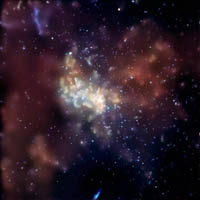Imagine the Universe News - 31 October 2006
Monster of the Milky Way
NASA Black Hole Research is Focus of PBS NOVA special
| 31 October 2006 |
At the core of the Milky Way sleeps a monster.

|
|
Chandra image of the supermassive black hole at our Galaxy's center, a.k.a. Sagittarius A*. (Credit: NASA/CXC/MIT/F.K.Baganoff et al.) |
A few years ago we didn't even know it was there. But now we know quite a bit about it: how much it weighs, how much it eats, and how it affects things near it. And we have a name for it, Sagittarius A*. But you can simply call it the monster black hole that lurks in the center of our galaxy.
On October 31 at 8:00 p.m. local time (check your listings), PBS will premier a NOVA program called "Monster of the Milky Way." Featuring interviews with research scientists and cutting-edge animations, the program shows how astronomers discovered this black hole and why they think that most large galaxies contain such a beast. In one sequence, viewers are treated to a computer animation showing what it would look like to fall into a supermassive black hole, based on Einstein's math.
Far from being insatiable devourers of everything around them, black holes seem to nurture star and galaxy formation by redistributing matter and energy. Life itself is likely made possible by the existence of black holes. Our central black hole is relatively quiet for now but may have been more active as recent as 300 years ago. Will it awake anytime soon?
NASA supports multiple missions that study black holes at different wavelengths. Landmark space surveys by NASA's Chandra X-ray Observatory and Hubble Space Telescope reveal that black holes are everywhere and come in a variety of sizes. NASA's Swift satellite has conducted the first unbiased census of black holes and has counted 200 active "awoken" supermassive black holes within 400 million light-years from Earth. NASA's Gamma-ray Large Area Space Telescope (GLAST)*, to launch in 2007, will study the great black hole paradox: how black holes, notorious for pulling matter in, also accelerate matter away at near light speed.
"Monster of the Milky Way" was funded in part by GLAST and the National Science Foundation. The program was made in conjunction with a planetarium show called "Black Holes: the Other Side of Infinity," which features the NASA Swift mission.
Visit the NOVA program site (http://www.pbs.org/wgbh/nova/blackhole/) for a black hole tutorial, animation, and an interview with NASA's Steve Ritz, the GLAST Project Scientist.
*GLAST launched on June 11, 2008.

